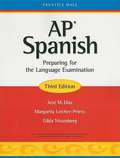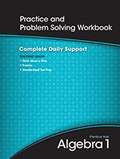- Table View
- List View
Predicting Outcomes Reading Comprehension Book Reading Level 3.5-5.0
by EdupressWelcome to the Edupress Predicting Outcomes Reading Comprehension Book. This resource is an effective tool for instruction, practice, and evaluation of student understanding. It includes ideas on how to introduce predicting outcomes to students, as well as activities to help teach and practice the concept. The reproducible activities in this book are tailored to individual, small-group, and whole-class work. They include leveled reading passages, graphic organizers, worksheets, and detailed instruction pages. These activities provide opportunities to use text, illustrations, graphics, and combinations of these elements to practice predicting outcomes while reading.
Prehistoric Europe
by Clive Gamble Timothy Champion Stephen ShennanThis book owes its existence to a need felt, we believe, by many people who are trying to teach European prehistory, for an elementary textbook suitable for students taking their first course in the subject with little or no previous experience in archeology.
Prentice Hall America, History of Our Nation (New York Edition)
by Michael B. Stoff James West DavidsonHistory textbook for New York students.
Prentice Hall New York Math A/B: An Integrated Approach, Volume 2
by Prentice Hall Editorial StaffMath textbook
Prentice Hall World History The Modern Era
by Elisabeth Gaynor Ellis Anthony EslerHistory textbook for high school
Prentice Hall AP Spanish: Preparing for the Language Examination
by Gilda Nissenberg Margarita Leicher-Prieto Jose DiazNIMAC-sourced textbook
Prentice Hall Advanced Mathematics: A Precalculus Approach, 1993
by Marilyn Ryan*This textbook has been transcribed in UEB, formatted according to Braille textbook formats, proofread and corrected.
Prentice Hall African-American History
by Darlene Clark Hine Stanley Harrold William C. HineThis textbook traces the history of Black people in America, from the time of first colonization to today. It describes slavery, the role of African-Americans in the Revolutionary War, the status of free Blacks in the Antebellum south, the abolition movement, the Civil War, emancipation, Reconstruction, the Harlem Renaissance, the role of Blacks in World War II, the civil rights and Black Power movements, and the lives of Black people in contemporary American society. Illustrations and profiles of prominent figures support the narrative. A companion CD-ROM contains speeches, songs, stories and poetry. The authors teach at Michigan State university and South Carolina State University.
Prentice Hall Algebra 1
by Pearson Prentice HallPrentice Hall Algebra 1 is focused, organized, and easy to follow. The program shows your students how to read, write, and understand the unique language of mathematics, so that they are prepared for every type of problem-solving and assessment situation.
Prentice Hall Algebra 1 (California Edition): Volume 1, Chapters 1 - 7
by Randall I. Charles John A. Dossey Stanley A. Smith Marvin L. BittingerThere are many features built into the daily lessons of this text that will help you learn the important concepts and skills you will need to be successful in this course. There are numerous Exercises in each lesson to give you the practice you need to learn. Practice Multiple Choice exercises are included in the lesson to help you prepare for success on your state test. The text also contains Error Analysis, Test Prep exercises, Critical Thinking exercises, Challenge exercises, etc.
Prentice Hall Algebra 1 (Foundations Series)
by Allan E. Bellman Sadie Chavis Bragg Basia Hall Dan Kennedy Siegfried Haenisch William G. Handlin Stuart J. MurphyThroughout this textbook, you will find content that has been developed to cover all of the American Diploma Project's (ADP) math benchmarks. The End-of-Course Assessment is modeled after the ADP Algebra 1 test and can serve as practice before taking the actual ADP test.
Prentice Hall Algebra 1 and Algebra and Trigonometry
by Paul A. FoersterApplications are handled by creating mathematical models of phenomena in the real world. Students must select a kind of function that fits a given situation, and derive an equation that suits the information in the problem. The equation is then used to predict values of y when x is given or values of x when y is given. Sometimes students must use the results of their work to make interpretations about the real world, such as what "slope" means, or why there cannot be people as small as in Gulliver's Travels. The problems require the students to use many mathematical concepts in the same problem. This is in contrast to the traditional "word problems" of elementary algebra, in which the same one concept is used in many problems.
Prentice Hall Algebra 1, Florida
by Randall I. Charles Basia Hall Dan KennedyNIMAC-sourced textbook
Prentice Hall Algebra 1, Florida Honors
by Randall I. Charles Basia Hall Dan KennedyNIMAC-sourced textbook
Prentice Hall Algebra 1, Michigan
by Randall I. Charles Basia Hall Dan KennedyNIMAC-sourced textbook
Prentice Hall Algebra 1, Oklahoma
by Randall I. Charles Basia Hall Dan KennedyNIMAC-sourced textbook
Prentice Hall Algebra 1, Pennsylvania
by Randall I. Charles Basia Hall Dan KennedyNIMAC-sourced textbook
Prentice Hall Algebra 1, Tennessee
by Randall I. Charles Basia Hall Dan KennedyNIMAC-sourced textbook
Prentice Hall Algebra 1, West Virginia
by Randall I. Charles Basia Hall Dan KennedyNIMAC-sourced textbook
Prentice Hall Algebra 1: Practice and Problem Solving Workbook
by Pearson Prentice HallStudents of Math will find the Prentice Hall Algebra 1: Practice and Problem Solving Workbook a very useful material to learn Algebra.


